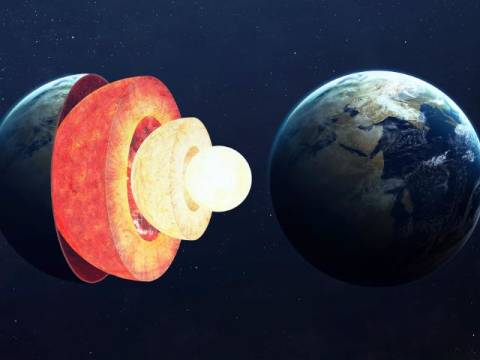
Opinion: The Earth's core is changing. What does that mean for us?
If a person is said to be grounded, it means that they are sensible and stable -- solid individuals who can be relied upon to give a careful and considered opinion. The very meaning of the term comes from the solidity and stability of the ground on which we walk. However, recent reports in the media have painted a different picture of what goes on beneath the ground -- one in which the core of the Earth is doing some very surprising and unexpected things.
A recent paper published in the journal Nature Geoscience describes a change in the motion of the Earth's core -- and with that news, headlines proliferated, some claiming that the Earth's core has stopped rotating.
But this interpretation is actually misleading. The Earth's core is not literally stopping; however it is changing.
The Earth is not a solid ball; it consists of several layers. There is the innermost core, which is a solid sphere about the same size as the planet Mars. Surrounding that is the outer core, which is liquid rock. The next layer is the mantle, which is sort of taffy-like in consistency. Finally there is the crust, which is the outermost layer-- the place where we live.
If the Earth were a solid ball, every layer would rotate in sync, spinning once per day. However, because of the layered structure, it is possible for the core of the Earth to rotate at a slightly different rate from the surface and other layers. And, in the 1990s, researchers used geological data taken over the previous few decades to show that the core of the Earth was rotating slightly faster than the rest of the Earth. The difference is tiny -- about 1° per year faster than the surface of the Earth.
This more recent study found that the rotation of the core is slowing. It isn't stopping, but is now rotating at the same speed of the Earth. Furthermore, it appears that the core might be slowing so that it will eventually rotate slightly slower than the Earth. This is scientifically interesting, but rather less dramatic than some of the headlines have suggested.
Researchers have seen this periodic change in the speed of the rotation of the Earth's core before and they still debate the rate at which it occurs, with some suggesting a 70 year cycle, while others suggest a much faster one.
For geologists, this is fascinating stuff. The radius of the Earth is just shy of 4,000 miles and the deepest well anyone has ever dug is a little over 7.5 miles deep. The crust under the Earth's continents can be about 40 miles deep, although the crust under the oceans can be much thinner. Figuring out the structure of the Earth requires indirect methods, involving studying how fast the waves from earthquakes travel through the Earth, or studying the rich treasure trove of data of how the sound from nuclear blasts pass through the Earth. With a few exceptions, nuclear testing stopped in the mid-1990s.
Breathy headlines aside, this recent study confirms earlier results showing that the inner core's rotation changes over time and helps geologists trying to figure out the mechanism whereby those changes occur. What geologists care about is the interplay between gravitational and magnetic forces within the Earth that speed up and slow down the core's rotation.
However, there is a much more important lesson to be drawn here, which is that scientists are able to make extremely precise measurements of what is going on under the surface of the Earth. This is a big deal -- after all, it's the only planet we have. What goes on under the Earth has huge potential consequences for humanity.
Consider the supervolcano that is slumbering below Yellowstone National Park. Every half a million years or so (sometimes longer), Yellowstone transforms into a volcano that spews hundreds or thousands times of more ash into the atmosphere than the 1980 eruption of Mt. St. Helens. While some have worried that perhaps the Yellowstone supervolcano is due for another eruption, recent studies have allayed the concern that the danger is imminent. However, given the magnitude of the damage such an eruption would occur, it is imperative that geologists continue to monitor what is going on.
And there is much more going on under the Earth's surface. The Earth's magnetic field guides ships at sea and lost hikers to safety. It's easy to believe that the familiar compass will always work, however geologists have shown that the Earth's magnetic field isn't constant. Indeed, every few hundred thousand years, the field flips, with magnetic south becoming north, and vice versa.
And, while a flip is probably not imminent, the location of magnetic north changes even on human time scales. In the early 1900s, it was located in northern Canada, however it has moved out into the Arctic Ocean and is now approaching Siberia.
By understanding more about the inner workings of the Earth, scientists will be able to help humanity prepare for significant changes in the Earth's magnetic field. If it happened, we'd have to change all instrumentation that relies on compasses to navigate.
We have but one planet and what happens inside of it can affect all of us. It is imperative that geologists continue to study what's going on inside our globe -- and this recent measurement of changes in the rotation of the Earth's core gives us some comfort that we are staying up to speed.
And...come on and admit it... that's pretty cool.